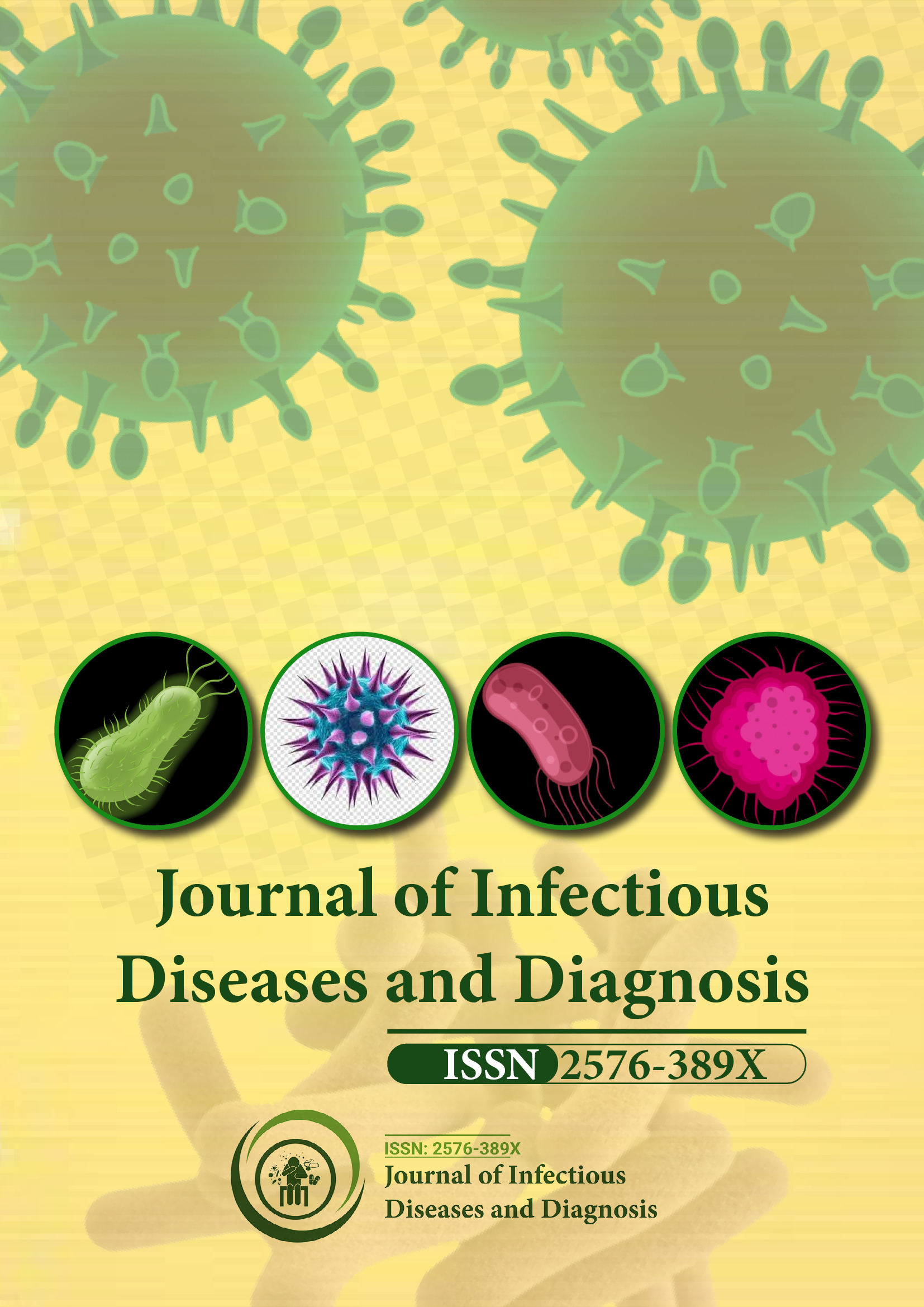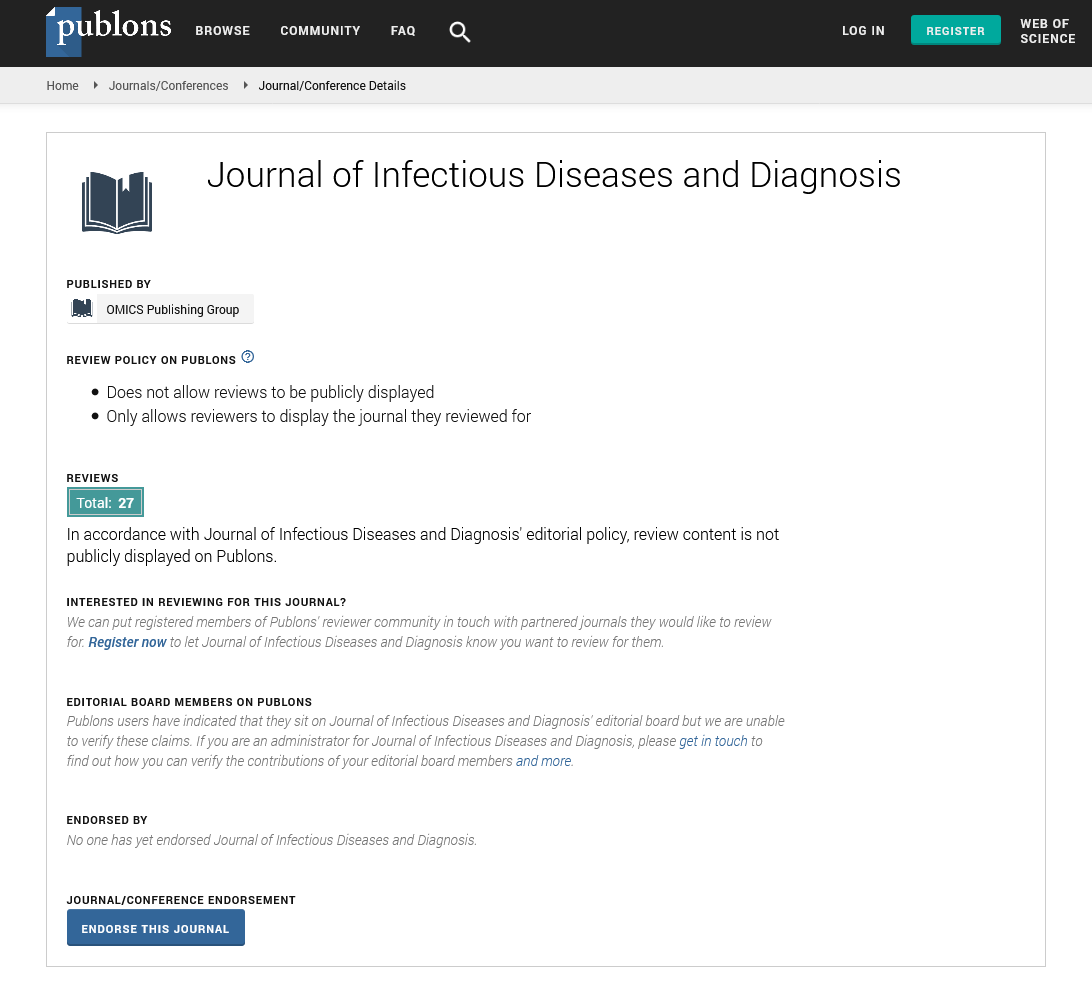Indexed In
- RefSeek
- Hamdard University
- EBSCO A-Z
- Publons
- Euro Pub
- Google Scholar
Useful Links
Share This Page
Journal Flyer

Open Access Journals
- Agri and Aquaculture
- Biochemistry
- Bioinformatics & Systems Biology
- Business & Management
- Chemistry
- Clinical Sciences
- Engineering
- Food & Nutrition
- General Science
- Genetics & Molecular Biology
- Immunology & Microbiology
- Medical Sciences
- Neuroscience & Psychology
- Nursing & Health Care
- Pharmaceutical Sciences
Opinion Article - (2025) Volume 10, Issue 4
Viral Pathogenesis and Control: Insights into Diagnosis, Treatment and Vaccine Development
Alex Nancy*Received: 30-Jun-2025, Manuscript No. JIDD-25-29512; Editor assigned: 03-Jul-2025, Pre QC No. JIDD-25-29512 (PQ); Reviewed: 17-Jul-2025, QC No. JIDD-25-29512; Revised: 24-Jul-2025, Manuscript No. JIDD-25-29512 (R); Published: 31-Jul-2025, DOI: 10.35248/2576-389X.25.10.345
Description
Viruses are among the most widespread and diverse biological entities on earth. They infect plants, animals, bacteria and even archaea, demonstrating remarkable adaptability to different hosts. Viral infections in humans represent a major global health concern, responsible for illnesses ranging from the common cold to life-threatening conditions such as HIV/AIDS, influenza, Ebola and COVID-19. Unlike bacteria, viruses are obligate intracellular parasites, meaning they cannot replicate outside host cells. Their ability to hijack host cellular machinery for replication underlies their pathogenic potential and the challenges faced in developing treatments.
Structure and characteristics of viruses
Viruses are typically composed of genetic material either DNA or RNA enclosed in a protein coat known as a capsid. Some viruses also possess a lipid envelope derived from the host cell membrane, which contains viral glycoproteins essential for host cell entry. The genetic diversity among viruses is immense, ranging from small single-stranded RNA genomes in picornaviruses to large double-stranded DNA genomes in herpesviruses. This diversity influences their replication strategies, host specificity and pathogenic effects.
Mechanism of infection
The viral infection cycle generally begins with attachment, where viral proteins interact with specific receptors on the surface of host cells. This specificity determines the range of organisms or tissues a virus can infect. Following attachment, viruses enter host cells either through direct fusion with the cell membrane, receptor-mediated endocytosis, or injection of genetic material. Once inside, the viral genome is released and redirected to host replication machinery.
For RNA viruses, replication often occurs in the cytoplasm, with viral RNA serving as a template for both protein synthesis and genome duplication. DNA viruses typically replicate in the nucleus, utilizing host enzymes. Retroviruses, such as HIV, carry reverse transcriptase, which converts RNA into DNA, allowing integration into the host genome. After replication and assembly, new viral particles are released through cell lysis or budding, spreading the infection to neighboring cells.
Host immune response
The human immune system plays a central role in controlling viral infections. The innate immune response acts as the first line of defense, involving interferons, natural killer cells and macrophages. Interferons are signaling proteins that restrict viral replication and activate immune cells.
The adaptive immune response provides more specific defense through antibodies and cytotoxic T lymphocytes. Antibodies neutralize viruses by blocking their attachment to host cells, while cytotoxic T cells destroy infected cells. Immunological memory ensures quicker and stronger responses upon subsequent exposure, forming the basis for vaccine protection.
Pathogenesis and clinical manifestations
Viral infections present with a wide spectrum of symptoms depending on the virus and host factors. Some infections, such as rhinovirus, cause mild upper respiratory illness, while others like Ebola virus lead to severe hemorrhagic fever. Viruses may cause acute infections, characterized by rapid onset and resolution, or persistent infections, where the virus remains in the body for extended periods.
Examples of persistent infections include chronic hepatitis B and C, which can lead to liver damage and latent herpesvirus infections, where the virus remains dormant and reactivates under certain conditions. Certain viral infections are also associated with oncogenesis, as seen with Human Papillomavirus (HPV) and cervical cancer or Epstein-Barr virus and certain lymphomas.
Diagnosis of viral infections
Accurate diagnosis is essential for managing viral diseases. Laboratory techniques include antigen detection, nucleic acid amplification (such as PCR), serology for antibody detection and viral culture. Molecular diagnostics have greatly improved sensitivity and specificity, allowing for early detection and monitoring of viral loads, as seen in HIV and hepatitis management. Rapid diagnostic tests are particularly valuable during outbreaks for immediate identification and containment measures.
Treatment strategies
Treating viral infections is challenging because viruses rely on host machinery for replication, making it difficult to target them without harming host cells. Antiviral drugs are designed to interfere with specific steps of the viral life cycle, such as entry, genome replication, or assembly. Examples include reverse transcriptase inhibitors for HIV, neuraminidase inhibitors for influenza and direct-acting antivirals for hepatitis C.
Combination therapy is often employed to reduce the risk of resistance, particularly in chronic infections like HIV. Supportive care remains essential for many viral diseases where specific antivirals are unavailable, focusing on symptom management and prevention of complications.
Prevention and control
Vaccination remains the most effective strategy for controlling many viral infections. Vaccines work by stimulating immune memory, preventing future disease upon exposure. Successful examples include vaccines against polio, measles, hepatitis B and more recently, COVID-19. Continuous research is directed at developing vaccines for viruses with high variability, such as HIV and influenza.
Public health measures, including vector control, safe blood transfusion practices, sanitation and public awareness campaigns, play important roles in reducing transmission. Quarantine and surveillance systems are crucial during outbreaks of highly transmissible viruses. Advances in biotechnology, such as mRNA vaccine platforms, have shown remarkable potential in accelerating vaccine development.
Conclusion
Viral infections remain a major challenge to global health, given their diversity, adaptability and potential for rapid spread. Understanding viral structure, replication, host immune responses and transmission pathways is essential for managing these diseases. While antiviral therapies and vaccines have improved outcomes for many infections, ongoing research is needed to address emerging viruses and persistent threats. Strengthening diagnostic capacity, advancing vaccine technologies and improving public health infrastructure are key steps in reducing the burden of viral diseases and preparing for future outbreaks.
Citation: Nancy A (2025). Viral Pathogenesis and Control: Insights into Diagnosis, Treatment and Vaccine Development. J Infect Dis Diagn. 10:345
Copyright: © 2025 Nancy A. This is an open-access article distributed under the terms of the Creative Commons Attribution License, which permits unrestricted use, distribution and reproduction in any medium, provided the original author and source are credited.

